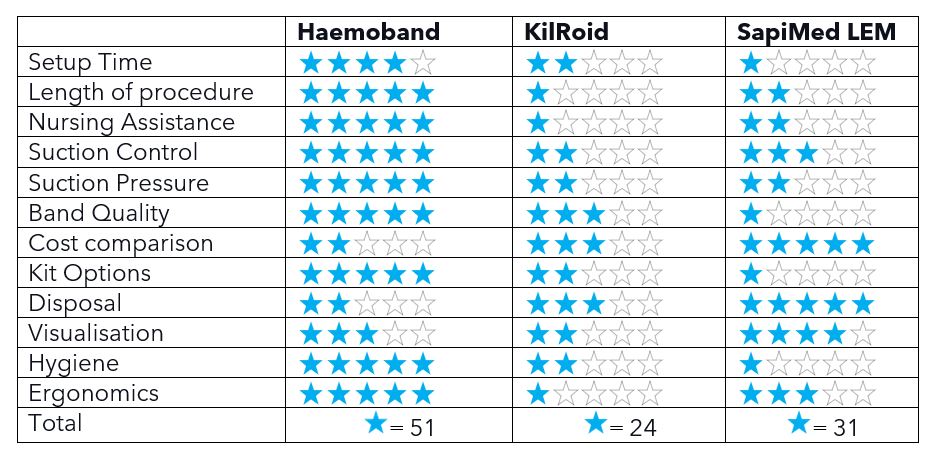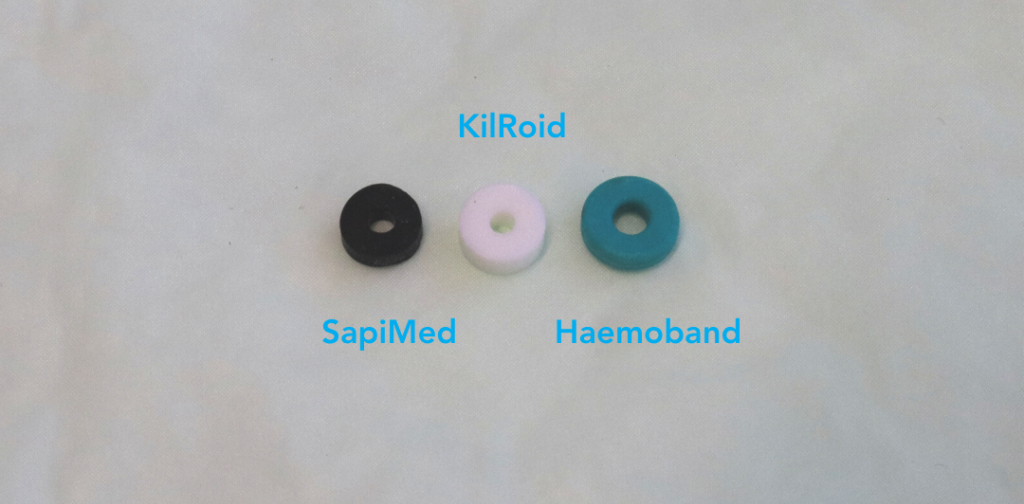Haemoband vs. KilRoid vs. Sapimed: Which Haemorrhoid Ligator is best for you?
At Hallmark Surgical, we often get asked why we have chosen to work with the Haemoband device and how it compares to other Haemorrhoid Ligators available.
If you are a Colorectal Surgeon or Nurse, you will know that there is a range of Haemorrhoid Ligators available on the market.
Therefore, we have put together this detailed comparison, including features, pricing and pros & cons of the three main ligators used in New Zealand – Haemoband, KilRoid and SapiMed.
To start with, let’s look at a comparison summary outlining the pros and cons of each on a scale from one to five:

As can be seen, by the chart, each ligator has its advantages and disadvantages. So, let’s discuss further the rating on each of these points.
Setup Time:
Time equals money. And in both setup and procedure, any time saving not only allows you to reduce appointment times and get more into every clinic, but it also reduces anxiety for patients.
Haemoband stands out for the time it saves you in setup. This is due to its clever pre-loaded design. With four bands pre-loaded onto the device’s tip, the Haemoband can be used straight from the packaging, with the connection of suction tubing being the only setup required.
KilRoid saves you time during setup as it comes with pre-attached suction tubing. However, significant time is required to load bands onto the device’s tip, with two separate loading cone devices used.
The SapiMed LEM device does not come with suction tubing attached. It is similar to the KilRoid in its band loading procedure, requiring significant setup time than Haemoband.
Length of Procedure:
Again, due to Haemobands best-in-class pre-loaded band system, it provides you with the shortest procedure length, allowing you to continuously band multiple haemorrhoids without removing the device from the anoscope or proctoscope to reload. A clinical study conducted with the Haemoband device shows that 96% of procedures took 2 minutes or less to complete.
Both KilRoid and Sapimed LEM have to be removed between each haemorrhoid and reloaded. Therefore your procedure time with these devices is significantly longer than with Haemoband. In addition, KilRoid scores lower than Sapimed LEM due to the complexity of using a double loading cone system to load bands compared to Sapimed LEM’s single cone.
Nursing Assistance:
Nursing time is a significant expense to any healthcare organisation, irrespective of whether you are a small practice where your receptionist assists with nursing or a busy outpatient department with several nurses on the team.
Haemoband does not require any nursing assistance because all bands are pre-loaded on the device. This allows your nursing team to focus on other tasks. When using both KilRoid and Sapimed LEM, many consultants prefer to have a nurse assisting during the procedure to load bands between haemorrhoids, preventing them from helping in other areas of the department or practice.
Suction Control:
Most haemorrhoid ligators are designed to be used with suction. This allows the haemorrhoid to be drawn into the tip of the device before a band is released. Two aspects of suction are reviewed in this comparison; Suction control and suction pressure/flow.
Suction Control is the amount of control the surgeon has over the suction flow. Haemoband’s dual-action trigger allows the surgeon to block all suction flow (when the trigger is in its natural position) or apply maximum suction strength when the trigger is retracted halfway. This is unique and offers the surgeon the most control of the three devices.
With KilRoid and Sapimed LEM, suction control is managed through a standard suction void. When the void is open, a large proportion of the suction escapes from the void reducing suction flow at the tip; when the void is covered, the suction flow is concentrated to the distal tip.

Band Quality:
Traditionally, ligation bands have been manufactured by being cut off long tubes of moulded material. This is why you often get irregular edges on ligator bands. The main disadvantage with this manufacturing method is the impact on the strength of the band. Because the bands are cut from a tube, small rubber fibres are being severed, and the overall integrity and strength of the band is diminished.
Both KilRoid and SapiMed use this method in the creation of their bands. Up until the mid-2010s, Haemoband also used this method. However, the weakness of standard ligation bands, coupled with the pre-loaded feature, meant that the bands were often stretched and didn’t provide good clinical outcomes.
Therefore, Haemoband made a major change and now every band on their banders is individually mould. Cutting is therefore eliminated and the rubber fibres remain complete. The result is greater band strength and elasticity. In addition, the added strength and size of the Haemoband bands means that double banding is not required with the Haemoband device.
Based on this, and the larger size of the Haemoband ligator bands, Haemoband scores highly for their band quality. KilRoid outscores Sapimed as the Kilroid bands are significantly larger than SapiMed but smaller than Haemoband.

Cost Comparison:
Haemoband is the most expensive out of all three bands, between $38-$50. Pricing depends on the volume used and whether you choose to include suction tubing, proctoscopes or both in the Hallmark Surgical haemorrhoid kits. See more about the Hallmark Surgical kits here: https://www.hallmarksurgical.com//products/colorectal/haemorrhoid-banding/
KilRoid is comparable to Haemoband in price, between $30-$35, while SapiMed is closer to the $10-$15 range. Unfortunately, neither KilRoid nor Sapimed have kits available with other necessary equipment for haemorrhoid banding procedures.
Disposal:
We often receive comments by concerned consultants about the disposal of Haemoband due to the apparent size of the device in comparison to the likes of KilRoid or Sapimed. Therefore, we have compared the weights of all devices to provide a analytical approach to the disposable comparison.
The Haemoband Ligator is the heaviest of all three ligators at approximately 120grams. The device is almost all plastic, except for one spring in the internal handle mechanism.
KilRoid weighs 95grams, which includes the pre-attached suction tubing. Unfortunately, for this comparison, the suction tubing cannot be removed from the ligator handle.
Sapimed weighs 35grams, making it the lightest ligator and the smallest for disposal.
Visualisation:
Visualisation of the surgical site is vital in all procedures, and ligator is essential in this, especially when working in the narrow confines of a 22-26mm proctoscope or anoscope.
Haemoband has the largest tip diameter at 15mm. However, it does feature a clear tip end and a shaft diameter of only 6mm, which is the section of the device that occupies the proctoscope channel during the procedure. Haemoband bands are highly visible, being green in colour, which assists in visulisation.
KilRoid has a 12mm diameter tip, and this diameter is maintained for the whole shaft. An interesting difference with KilRoid is that the bands are the same colour as the end of the device, making it hard to distinguish these and tell whether the band has been released.
Sapimed scores best in visualisation with a tip diameter of 12mm and a shaft diameter of 10mm. A point of difference with SapiMed is that it has a 20 degree angled tip, allowing for better visualisation and black bands to assist with identifying when the band has been released.

Hygiene:
The number one hygiene concern with haemorrhoid ligators is the band reloading procedure.
The Haemoband Ligator incorporates both suction control and band releasing into its dual-action trigger system. This provides a simple one-handed operation, and once inserted, the device does not need to be removed from the proctoscope between banding to reload bands.
KilRoid, as already discussed, needs to be removed between each haemorrhoid and reloaded. As known by many users, this is a very unpleasant task. KilRoid assists the user by providing a double loading cone system designed to prevent the user from touching the tip directly.
SapiMed LEM has the lowest score as the reloading procedure requires direct contact with the device tip in comparison to KilRoids double cone system.
Ergonomics:
Haemoband is renowned for its ergonomics. As designed for surgeons by surgeons, this has been a key part of the Haemobands value. Not only does it sit very comfortably in your hand, but the surgeon has also precise control over the suction flow and band release through a strong positive trigger action. In addition, the Haemoband device has specially designed ridges on the tip, meaning only one band can be released at a time, and the surgeon is in no doubt each time a band is released.
The KilRoid device is a 12mm Tube that runs in the same diameter
from the tip to the suction tubing, providing limited ergonomic shape or support. Firing the band is achieved by sliding a plastic tab and frame forward along tube with your thumb. The plastic tab needs to be retracted again before loading a new band; there is no auto-retract or spring action in the device.
The SapiMed LEM device is a small pistol shape mainly constructed from a single moulded piece. However, this device does have a trigger for firing bands that automatically retracts once released. This added design feature means it scores higher than the KilRoid device.
Summary:
All devices compared are manufactured by high-quality medical device companies in Europe, and as shown above, each has their key benefits and features, and are preferred by end-users for different reasons.
In our view, you should consider SapiMed if you are looking for the lowest cost trigger action haemorrhoid ligator. Of course, you will have to forgo key benefits such as reduced procedure setup and duration, band quality, and suction control, but you will have a competent, cost-effective bander with a low waste impact.
KilRoid should be considered by users who are familiar with the KilRoid design. The firing mechanism is quite different in method to the trigger-style of SapiMed and Haemoband. Nevertheless, KilRoid is a good all-rounder, which is reflected in its medium price-point. Like SapiMed, you will have to forgo key benefits such as reduced procedure setup and duration and suction control, but you will have an reliable bander with good quality bands.
Haemoband Ligators should be considered by consultants who want the best equipment and devices. As clearly shown by the above comparison, it is the market leader. If you are willing to manage the extra cost and feel the clinical benefits outweigh the increased waste impact, Haemoband is for you. You will get a device the greatly reduces your procedure setup and duration, reduce your dependence on your nursing teams, and have excellent clinical outcomes through market-leading band quality and suction control.
We trust you have found this to be of interest. Hallmark Surgical is committed to being a market leader in Colorectal equipment and devices and welcomes any questions you may have about haemorrhoid banders or other devices.
